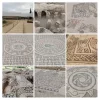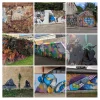Aurigny
Active Member
- Time of past OR future Camino
- Francés; Português Central; Português Interior; Primitivo; Português da Costa; Invierno; Gebennensis
Last October I commenced my first really long route to SdC, starting more or less from outside the front door of the flat in Geneva from whose upstair windows I used wistfully to observe pilgrims commencing their journey. Given work constraints, this will have to be a multi-year project. I was able to complete the Gebennensis section (about which I wrote here), arriving in Le Puy just before Emmanuel Macron imposed the first nationwide curfew and shut the whole thing down. Now, fully vaccinated and with a modest amount of free time available, I'm picking up where I left off and starting out on the Podiensis.
I've no idea how far I'll get. There's not the slightest chance of doing the whole thing, or anything remotely resembling it, before I have to resume normal duties. If everything goes flawlessly, which it never does, Moissac would be a possibility; more realistically, I'd estimate at the moment that I'll run out of time midway between Conques and there. But of all the years, this is not the one to stress about such things. For all I know, the plug may be pulled on all of us before we get out of the starting gate. Indeed, a few people were speculating yesterday that the President might do just that. (In a televised address last night, he stopped short of that drastic step. Instead he announced that from August, those who can't document their immunity status will be denied access to shops and restaurants. The all too predictable consequence, for those of us who know and love France, was an immediate crash of the vaccination-booking website as thousands of viewers tried to log on all at once.)
My sojourn on the Gebennensis was enlivened, and physically lengthened, by the challenge of obtaining somewhere to stay each night. Early indications are that this task may be even more difficult on the Podiensis at present. Having been cooped up for so long, large numbers of randonneurs(-euses) have descended on the town, this being an important way-station on the GR 65 hiking that overlies the Chemin de Compostelle. As a fail-safe, I've brought a lightweight sleeping bag and an air mattress with me so that, should there be no room at the inn, I can doss down for a few hours in an unused bus shelter or the equivalent.
I've also thought it prudent to book ahead for the first few days. Last night, that meant the Gîte d'Etape des Capucins, from the kitchen of which this is being composed. From all appearances, the coronavirus is having very little impact on its operations. Each of its four dortoirs is as crowded with bunk beds as ever, and each bunk is currently occupied by a soundly—and, in most cases, resonantly—sleeping inhabitant. At EUR 22, petit déj not included, it's not a particularly cheap option, but French routes operate according to their own economic rules.
I'm going to try to snatch another couple of hours' sleep myself, if the snorers will permit, and then catch 07:00 Mass at the cathedral, no more than five minutes' walk away. After that, the open road beckons. It doesn't appear that I'm going to want for company along the way.
I've no idea how far I'll get. There's not the slightest chance of doing the whole thing, or anything remotely resembling it, before I have to resume normal duties. If everything goes flawlessly, which it never does, Moissac would be a possibility; more realistically, I'd estimate at the moment that I'll run out of time midway between Conques and there. But of all the years, this is not the one to stress about such things. For all I know, the plug may be pulled on all of us before we get out of the starting gate. Indeed, a few people were speculating yesterday that the President might do just that. (In a televised address last night, he stopped short of that drastic step. Instead he announced that from August, those who can't document their immunity status will be denied access to shops and restaurants. The all too predictable consequence, for those of us who know and love France, was an immediate crash of the vaccination-booking website as thousands of viewers tried to log on all at once.)
My sojourn on the Gebennensis was enlivened, and physically lengthened, by the challenge of obtaining somewhere to stay each night. Early indications are that this task may be even more difficult on the Podiensis at present. Having been cooped up for so long, large numbers of randonneurs(-euses) have descended on the town, this being an important way-station on the GR 65 hiking that overlies the Chemin de Compostelle. As a fail-safe, I've brought a lightweight sleeping bag and an air mattress with me so that, should there be no room at the inn, I can doss down for a few hours in an unused bus shelter or the equivalent.
I've also thought it prudent to book ahead for the first few days. Last night, that meant the Gîte d'Etape des Capucins, from the kitchen of which this is being composed. From all appearances, the coronavirus is having very little impact on its operations. Each of its four dortoirs is as crowded with bunk beds as ever, and each bunk is currently occupied by a soundly—and, in most cases, resonantly—sleeping inhabitant. At EUR 22, petit déj not included, it's not a particularly cheap option, but French routes operate according to their own economic rules.
I'm going to try to snatch another couple of hours' sleep myself, if the snorers will permit, and then catch 07:00 Mass at the cathedral, no more than five minutes' walk away. After that, the open road beckons. It doesn't appear that I'm going to want for company along the way.




























